Consumers encounter a range of branding strategies and companies derive different benefits from the types of branding they pursue. In 2021, Visual Objects surveyed consumers and found that they were most likely to encounter product, retail, and service branding and that experts believe all of these branding strategies help companies improve their product sales and business reputation.
Updated June 9, 2022
Sometimes, it can feel like a bombardment.
Advertisements, logos, slogans, and other kinds of business promotion are a daily occurrence for consumers. They may wonder, why do businesses so aggressively market their services and values?
The answer is to build a brand.
Branding is the promotion of a product or company through advertising and design. Some branding strategies are more popular than others. In the span of 2020 and 2021, the types of branding materials consumers were most likely to encounter include:
- Product (39%)
- Retail (37%)
- Service (31%)
- Corporate (22%)
- Personal (18%)
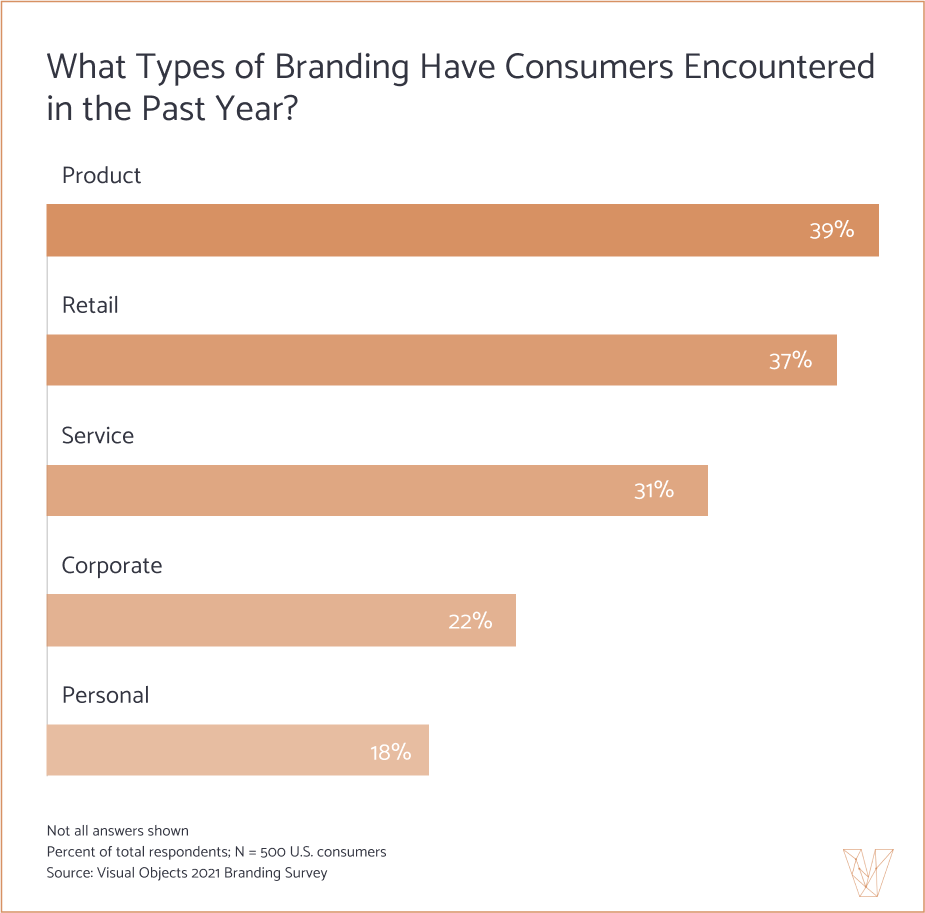
Determining what types of branding strategies most help their business can be difficult for small business owners and managers. But experts say that each form of branding influences consumers in different ways and has its own set of benefits.
Companies can use this report to understand the benefits and strategies behind different types of branding.
Businesses with a strong grasp on branding or that partner with an effective branding company are more likely to give customers good reasons to buy their products and services.
5 Types of Branding for Small Businesses
- Product branding: 39% of consumers have encountered promotions for products in the past year, demonstrating that product branding is an essential part of branding.
- Retail branding: 37% of consumers say they encountered retail branding in the past year, and 59% of people say that retail branding, such as a business’s store layout, affects their opinion of the company. Retail branding is an important business strategy that affects consumer sentiment.
- Service branding: 31% of people say that they last hired a company providing a service such as accounting or plumbing because of a word-of-mouth reference. The most common way services are branded, especially for older consumers, is from one person to another.
- Company branding: 22% of consumers say they encountered company branding, such as an advertisement promoting a business’s values instead of its products, at some point in the past year. But 50% of consumers say that company branding affects their opinion of the business, suggesting that businesses should emphasize authentic, consistent, and lasting brand values.
- Personal branding: 18% of people experienced personal branding, such as influencer-endorsed products, in the past year. Experts say that when branding materials feature people’s stories, consumers are more likely to understand a product’s appeal.
1. Product Branding
Companies are made up of products, so the type of branding that consumers are most likely to encounter is product branding.
Nearly 4 in 10 people (39%) saw product branding materials between 2020 and 2021.
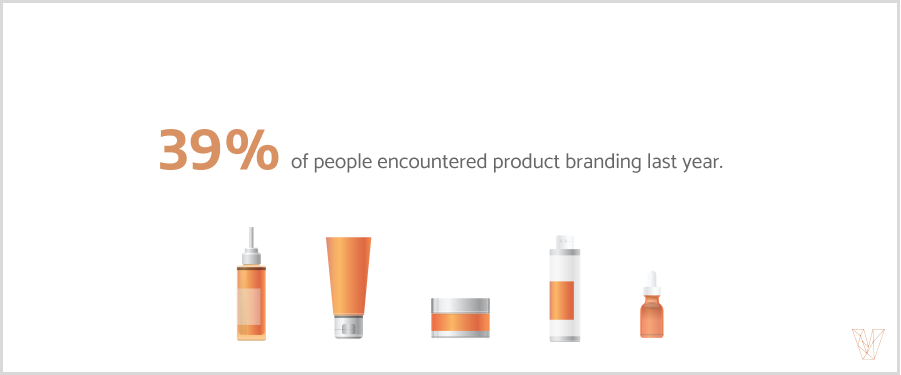
Experts say that product branding gives consumers a reason to purchase your company’s products.
“When people are shopping, no one wants to buy anything that has never been discussed or used before,” said Edward Mellett, founder of WikiJob.co.uk, a career and jobs site. “Promoting your product informs customers about the product they are purchasing and why they should purchase it.”
Mellett believes that many companies are branding products in crowded markets, so an individual product’s brand is essential to a brand development process.
Other experts believe that product branding is an opportunity to tell a story about your company and your products.
“Branding gives products an identity,” said Debra Pokallus, founder of Bel Essence, which sells natural skincare products. “People know the mission and values of our company through our products.”
Bel Essence’s products typically have descriptors such as “detoxifying” or “natural” in their names. And Bel Essence products frequently contain and display natural ingredients such as tea tree or sunflower oil.
Pokallus says that Bel Essence’s logos, fonts, colors, and packaging designs are only effective if consumers can tie them to the company’s larger values of health and sustainability.
For businesses, product design services offer the opportunity to tie specific products to a company’s broader mission and ideals.
Additional Reading: 'Tips & Tricks for Product Video Production'
2. Retail Branding
Many of us have stories about impossible-to-navigate stores, unfriendly sales associates, unprofessional websites, and the worst kind of post-shopping feeling: I’m never going there again.
More than one-third of consumers (37%) say they encountered retail branding, which encompasses in-person or virtual design and layout, at some point during the period of 2020 and 2021. Close to 6 in 10 people (59%) said that retail branding affects their opinion of the company hosting them at their store or on their website.
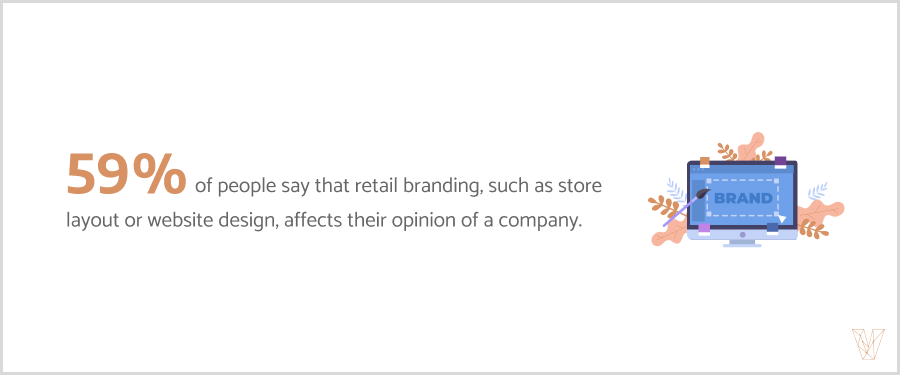
Experts say that retail branding is important because it ties customers’ shopping experience to your brand’s goals.
“Creating an atmosphere for shopping that is aligned with your brand is a critical component of shaping your brand experience,” said Melissa Packham, chief brand strategist for A Brand is Not a Logo, a marketing and advertising agency.
Read this: 'What is Retail Branding?'
Packham says that an example of a distinct retail branding experience is shopping at the Apple Store.
Apple Stores are neat, minimalist, and sleek. Associates are available to help and consult customers and the range of Apple’s product offerings line the walls.
Packham contrasts the distinct experience of shopping at an Apple Store with shopping at a discount electronics outlet, which often feel nondescript. When you’re in an Apple Store, you know it’s an Apple Store, and Packham believes this provides Apple a significant competitive advantage.
Other experts say that the principles of retail branding should be applied to the growing field of e-commerce.
“When consumers are shopping online, they are looking for convenience and tools that assure them they are making the best purchasing decisions possible,” said Matthew Paxton, founder of Hypernia, a guide to video gaming servers and consoles. “Your website's layout, design, loading speed, functionality, and access to customer reviews all contribute to how customers view your brand.”
Web designers that built sites with a strong user experience makes it more likely that customers will purchase your products and carry a positive association of your brand.
Online and in-person, retail branding is an important part of a business’s image.
3. Service Branding
Services can be difficult to brand. Many people could cut your lawn, fix your pipes, or represent you in court. The cost of a bad hire for these services, however, leads customers to trust word-of-mouth interactions for choosing a provider.
More than one-third of people (36%) said that the last time they hired a company to provide a service, it was because they heard about the provider from an acquaintance.
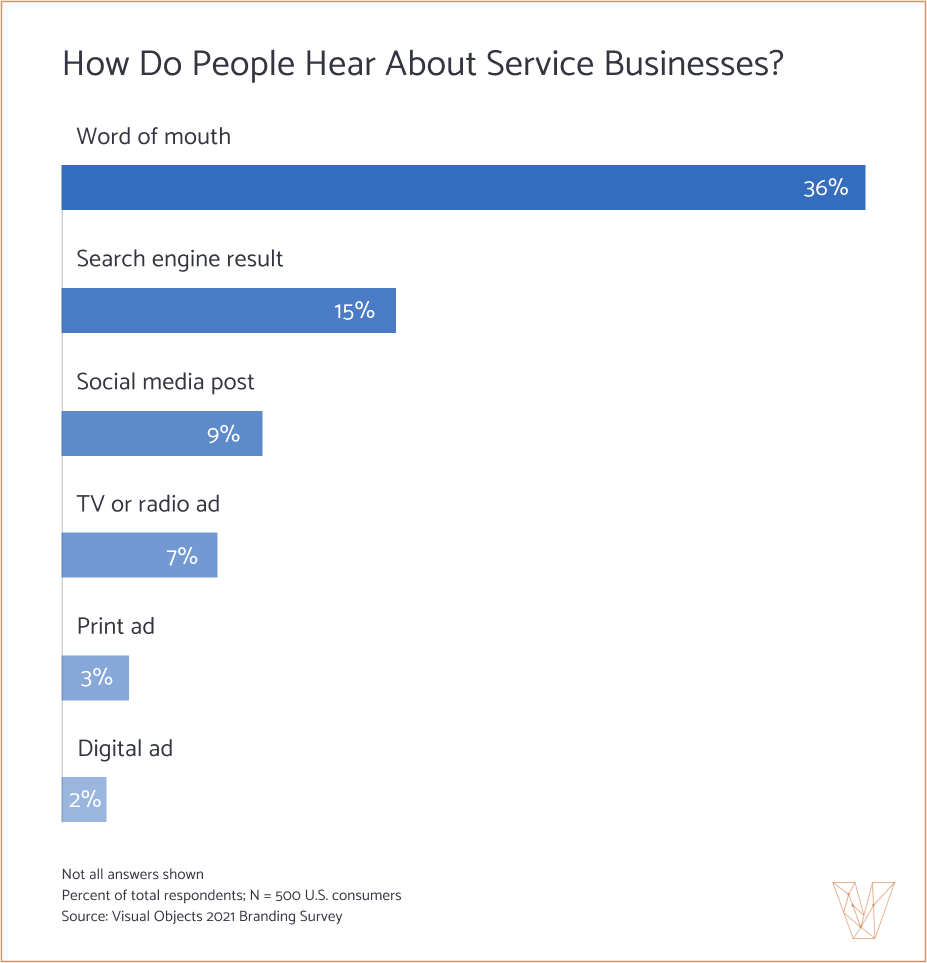
Other ways that consumers heard about a service provider include:
- Search engine results (15%)
- Social media posts (9%)
- Television or radio advertisements (7%)
- Physical advertisements such as billboards (3%)
- Digital advertisements such as website banner ads (2%)
Experts say that word of mouth referrals are important for service branding because the services being provided are especially personal for consumers.
Jay York is the chief executive and founder of Grove Brands, a marketing and branding company.
Many of York’s clients are businesses that offer trade services, such as painting. York encourages those companies to remember that the services they provide are “intimate.” Painting someone’s home or renovating their bathroom is different than simply selling them a product. The results are lasting and can be costly to alter, so consumers are more likely to hire a provider already vetted by their network.
York says that the best way to pursue service branding is to make sure that your clients are having positive experiences and encourage them to refer your services to other people in your business’s community.
Hearing about services through word of mouth networks is especially common for older consumers.
Close to half of consumers ages 55 and over (46%) said they last hired a service provider after hearing about it through word of mouth. Only 34% of 35 to 54 year olds and 22% of 18 to 34 year olds said the same.
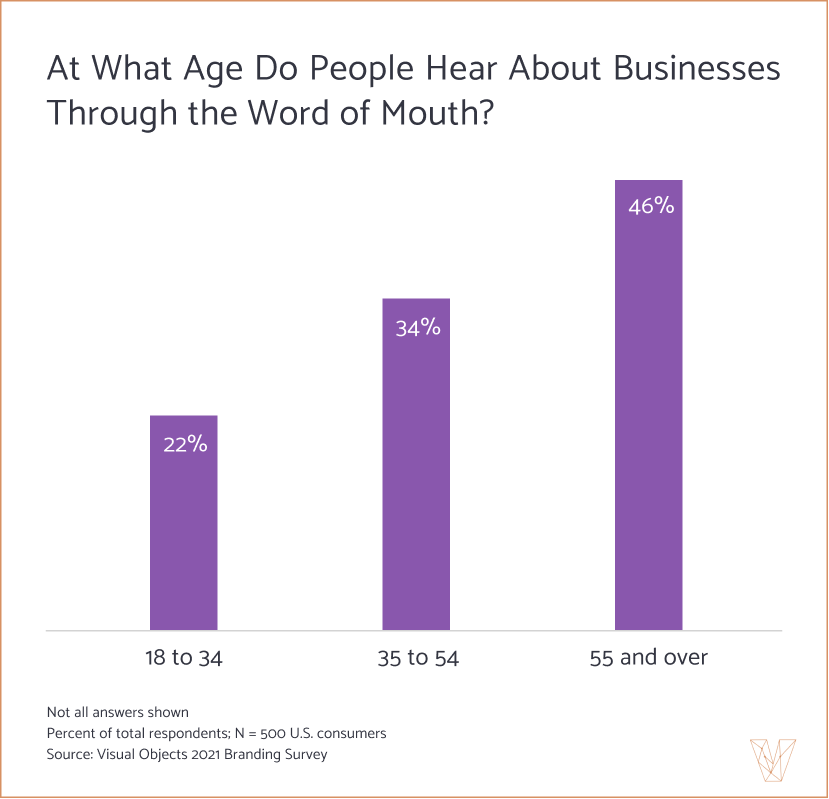
Experts suggest that companies offering services should reach younger consumers by capitalizing on word of mouth-style features on social media.
“Modern word of mouth referrals now mostly come through positive reviews
from existing customers,” said Robert Brandl, founder and chief executive of WebsiteToolTester, a website builder for small businesses.
Brandl says that companies should facilitate these positive reviews by adding social sharing buttons to their website. This way, customers can let their social networks know when they have a positive experience with a service provider.
Compared to other forms of branding, service branding will likely continue to rely on recommendations from consumers’ acquaintances.
Additional Reading: '5 Service Branding Tips for Your Company'
4. Company Branding
It stands to reason that a business’s products are easier to sell when the business has a strong reputation.
But branding a business is not easy. Only 22% of consumers report having seen corporate branding, such as advertisements about a company’s values, in 2020 and 2021. Still, half of people (50%) said that company branding affects their opinion about the featured business.
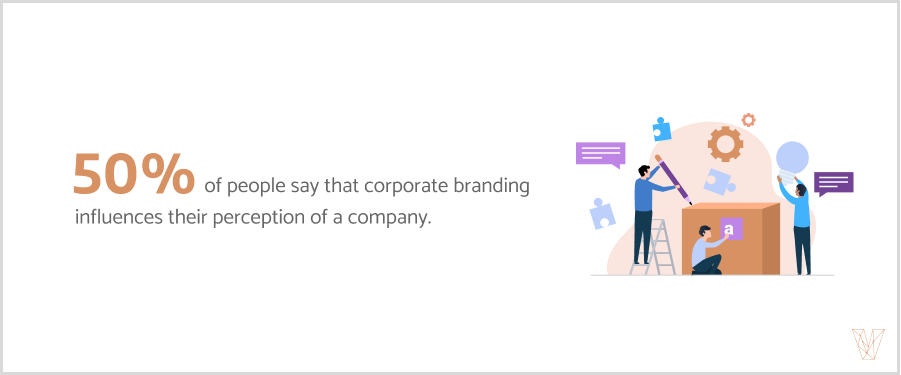
Experts say that businesses have to overcome customer’s overexposure to and skepticism about advertising and brand building.
“We are bombarded with advertising content and media all day long,” said Kate Bourque, a branding and web design consultant. “Customers are more attuned to advertising than ever and see through anything that looks inauthentic or disingenuous.”
Bourque says that consumers are more likely to make associations about a brand and company identity on a “subconscious” level. Telling consumers your business cares about the environment probably means less than selling eco-friendly products. Crowing about your company’s commitment to diversity is meaningless unless your branding materials reflect the diversity of your target audience.
To Bourque, the way that a company brands its products says more about its values than a commercial announcing them.
Other experts say that consistency is the key to company branding.
“It's important to have a consistent style and tone in your corporate communications when building a corporate brand,” said Timothy Robinson, chief executive of InVPN, which publishes reviews and ratings about virtual private networks.
Robinson says that with consistent communication, logos, customer service, and visuals, companies can develop a brand voice that displays their values without inauthentically advertising them.
Focusing on “subconscious” forms of company branding such as having a consistent brand voice and tying products to broader business values can help your organization develop a strong identity and reputation.
5. Personal Branding
Charging people with the enthusiasm to buy a product isn’t easy, so some companies use personal branding, such as customer testimonials and referrals from friends or family, in order to market their product.
About one-fifth of people (18%) encountered personal branding materials in 2020 and 2021.
Experts say that personal branding is important because it places people, not companies, as the protagonists of a story.
“People can’t see themselves reflected in a story about a faceless organization,” said Daniel Foley, chief marketing officer at Scooter Guide, which produces electric scooter ratings and reviews. “Great, emotional brand storytelling must be told through the lens of a person: a specific customer, a passionate employee, or a dedicated partner.”
Personal branding can tell the story of a customer or business owner or employee, so long as the worth of a company is rooted in its relationship or value to an individual.
Examples of personal branding include Shaquille O’Neal’s famous IcyHot commercials, or branding relationships with Instagram influencers who market certain products.
“You can’t hug or thank a company,” Foley said. But you can hug or thank a person, and for this reason personal branding is a valuable and relatable branding strategy.
Businesses Can Use Different Types of Branding Strategies
Branding isn’t easy, but deciding which branding strategies to employ is a normal challenge for small businesses.
In the past year, consumers were most likely to have encountered:
- Product branding (39%)
- Retail branding (37%)
- Service branding (31%)
- Corporate branding (22%)
- Personal branding (18%)
Experts say that each form of branding provides businesses certain benefits:
- Product branding gives people a reason to purchase a specific product.
- Retail branding makes consumers’ shopping experience simpler and more enjoyable.
- Service branding relies on companies building their word of mouth networks.
- Corporate branding works to improve consumer sentiment about a business.
- Personal branding helps businesses tell compelling stories about people.
With specific, detailed branding plans, businesses can sell more products, improve their reputation, and boost profits.
Hire a branding agency to support your company's branding strategy.
About the Survey
Clutch surveyed 500 people in the U.S. in 2021.
Thirty-seven percent of respondents (37%) live in the South; 30% live in the Midwest; 18% live in the West; 15% live in the Northeast.
Thirty-six percent of respondents (36%) are male; 32% are female; 33% did not identify their gender.
Ten percent of respondents (10%) are between 18 and 34 years old; 24% are between 35 and 54 years old; 32% are 55 and over; 34% did not provide their age.